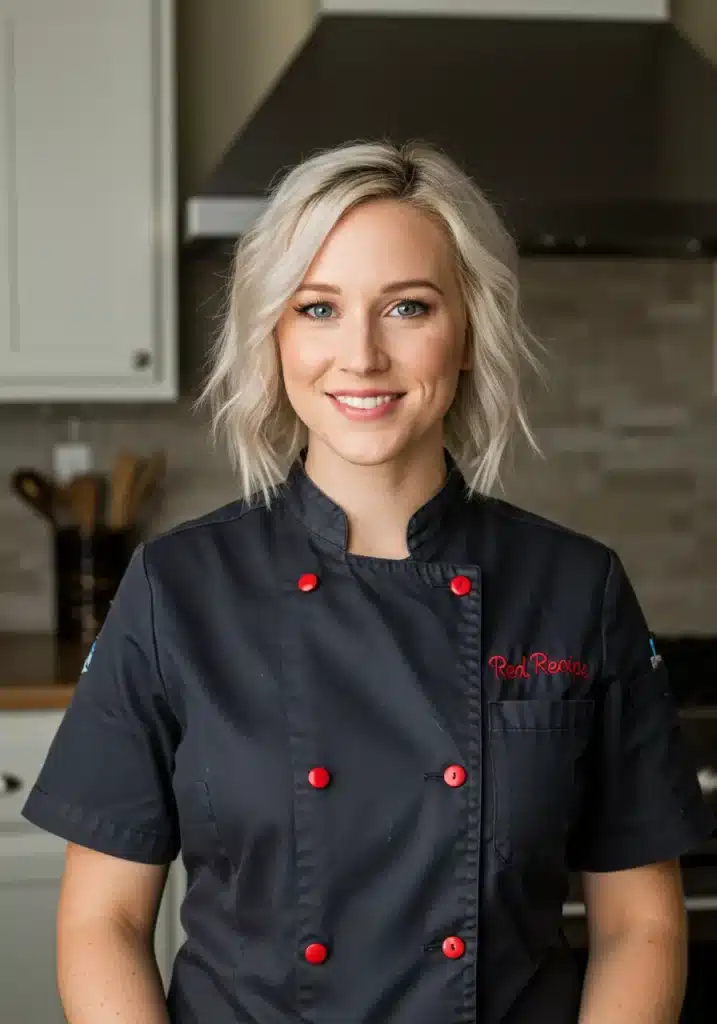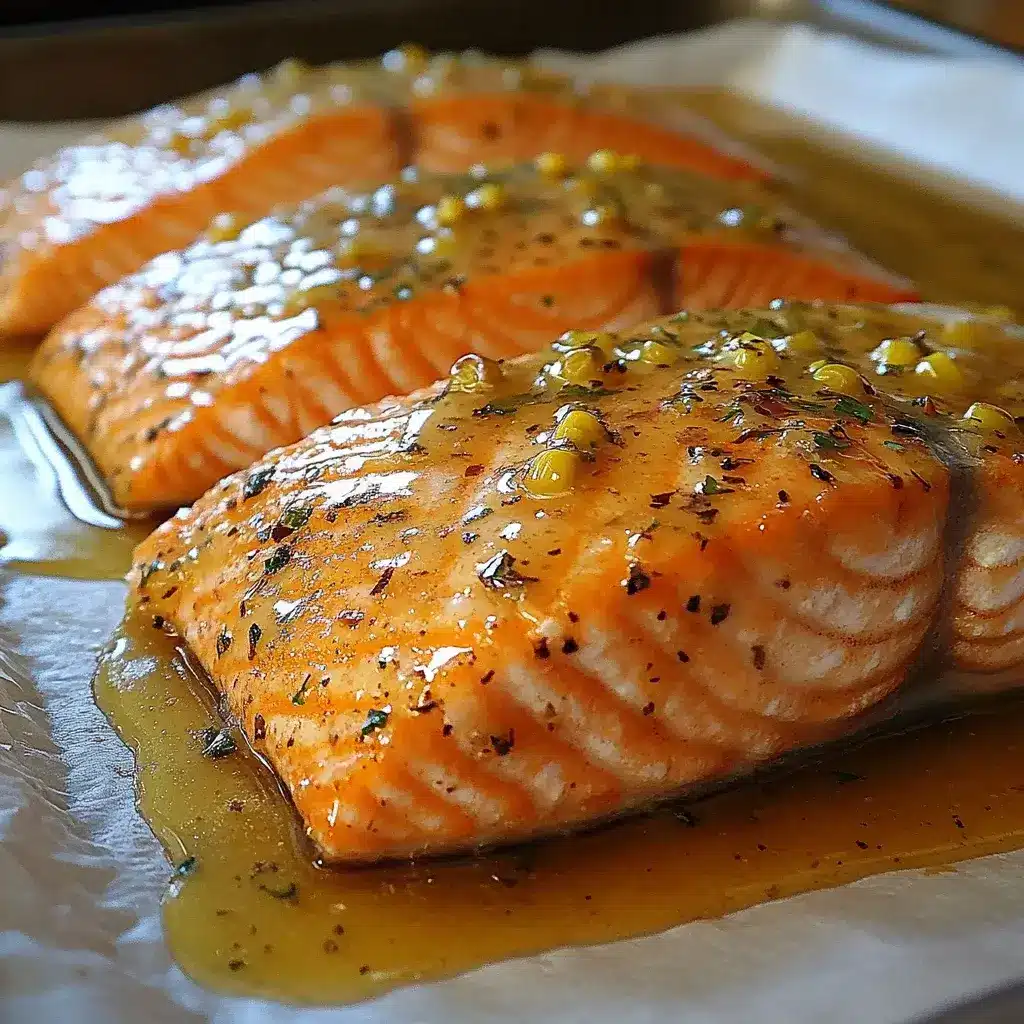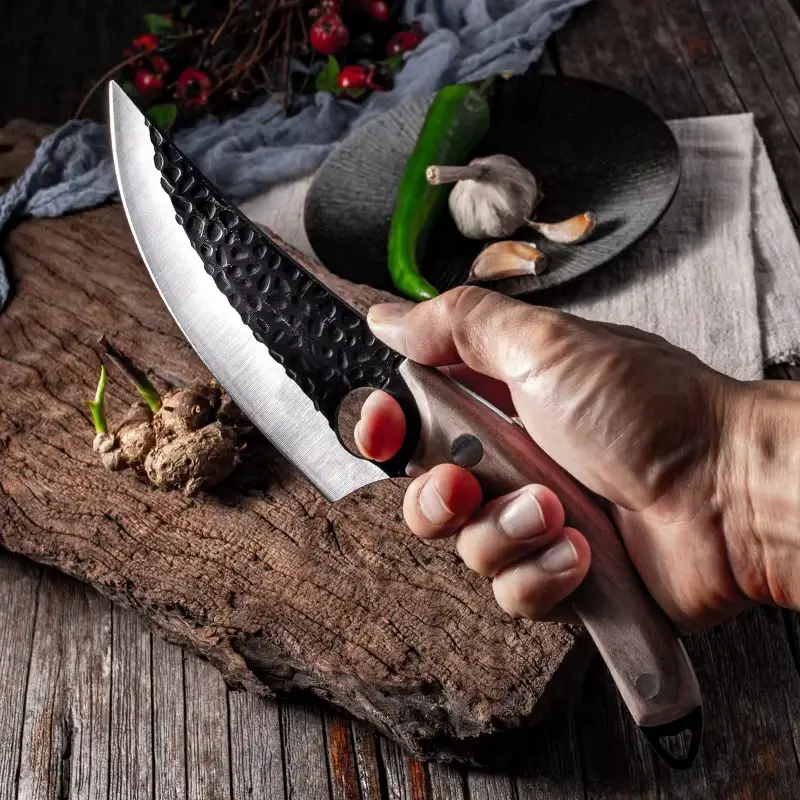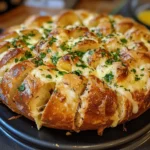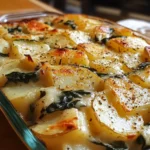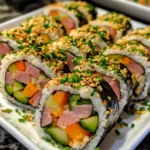Let me tell you, there are weeknight dinners, and then there are weeknight dinners. This Baked Salmon with Brown Sugar Glaze falls firmly into the latter category. It’s become a staple in our home, not just because it’s incredibly easy to throw together after a long day, but because it’s genuinely delicious. Even my pickiest eater, who usually eyes anything from the sea with suspicion, devours this salmon with gusto. The sweet and savory glaze creates this beautiful caramelized crust that’s just irresistible, while the salmon itself stays wonderfully moist and flaky. It’s the kind of dish that feels both special enough for company and simple enough for a Tuesday night. Honestly, if you’re looking for a way to make salmon exciting, or even if you’re just trying to incorporate more healthy fish into your diet, this recipe is a game-changer. Prepare to be amazed at how quickly this dish becomes a family favorite – it certainly did in ours!
Ingredients
- Salmon Fillets: Fresh or frozen (thawed), skin on or off, about 1.5-2 pounds. Salmon is the star, providing rich flavor and healthy fats.
- Brown Sugar: Light or dark brown sugar, ½ cup packed. Brown sugar creates the signature sweet and caramelized glaze, adding depth of flavor.
- Soy Sauce: Low sodium soy sauce, ¼ cup. Soy sauce brings a savory umami element to balance the sweetness and tenderize the salmon.
- Olive Oil: Extra virgin olive oil, 2 tablespoons. Olive oil adds moisture and helps the glaze adhere to the salmon, also contributing healthy fats.
- Lemon Juice: Freshly squeezed lemon juice, 2 tablespoons. Lemon juice brightens the flavors, cuts through the richness, and complements the salmon beautifully.
- Garlic Powder: 1 teaspoon. Garlic powder adds a subtle savory depth to the glaze, enhancing the overall flavor profile.
- Paprika: Smoked paprika or regular paprika, ½ teaspoon. Paprika adds a touch of smokiness and color to the glaze, deepening the flavor.
- Black Pepper: Freshly ground black pepper, ¼ teaspoon. Black pepper provides a subtle spice and enhances all the other flavors.
- Optional Garnishes: Fresh parsley, lemon wedges, sesame seeds. These garnishes add visual appeal and a fresh finish.
Instructions
- Preheat the Oven and Prepare Baking Sheet: Preheat your oven to 400°F (200°C). Line a baking sheet with parchment paper or foil for easy cleanup. Parchment paper prevents sticking, while foil can be helpful for containing any glaze drips.
- Prepare the Salmon: If using frozen salmon, ensure it is fully thawed. Pat the salmon fillets dry with paper towels. This helps the glaze adhere better and ensures a nice sear if you choose to broil at the end. Place the salmon fillets skin-side down (if skin-on) on the prepared baking sheet, leaving some space between each fillet for even cooking.
- Make the Brown Sugar Glaze: In a small bowl, whisk together the brown sugar, soy sauce, olive oil, lemon juice, garlic powder, paprika, and black pepper until well combined. Ensure the brown sugar is mostly dissolved into the liquid ingredients, creating a smooth glaze.
- Glaze the Salmon: Generously brush the brown sugar glaze evenly over the top and sides of each salmon fillet. Make sure each piece is nicely coated to maximize flavor and caramelization. You might have a little glaze leftover, which is perfect for basting later.
- Bake the Salmon: Place the baking sheet in the preheated oven and bake for 12-15 minutes, or until the salmon is cooked through and flakes easily with a fork. The cooking time will vary depending on the thickness of your salmon fillets. Start checking for doneness around 12 minutes. The internal temperature should reach 145°F (63°C).
- Optional Broil for Caramelization (Optional): For an extra caramelized and slightly crispy top, you can broil the salmon for the last 1-2 minutes of cooking. Keep a very close eye on it to prevent burning, as the brown sugar glaze can caramelize quickly under the broiler. Position the baking sheet about 6 inches from the broiler and broil for a short time until the glaze is bubbly and slightly darkened.
- Rest and Garnish: Once cooked, remove the salmon from the oven and let it rest for a few minutes before serving. This allows the juices to redistribute, resulting in more tender and flavorful salmon. Garnish with fresh parsley, lemon wedges, and sesame seeds (if using) for added freshness and visual appeal.
- Serve Immediately: Serve the baked salmon immediately while it’s warm and the glaze is still glistening. It pairs wonderfully with a variety of sides (see “How to Serve” section below).
Nutrition Facts
(Per Serving, approximate, based on 4 servings using 6 oz salmon fillets)
- Serving Size: 1 fillet (approx. 6 oz cooked salmon)
- Calories: ~450 kcal
- Protein: 40g
- Fat: 25g
Note: Nutritional values are estimates and can vary based on specific ingredients, portion sizes, and salmon type. For precise nutritional information, use a nutrition calculator with the specific brands and quantities of ingredients used.
Preparation Time
- Prep Time: 10 minutes (This includes gathering ingredients, making the glaze, and preparing the salmon for baking.)
- Cook Time: 12-15 minutes (Baking time in the oven, may slightly vary based on fillet thickness and oven.)
- Total Time: 22-25 minutes (From start to finish, this recipe is quick and perfect for busy weeknights.)
How to Serve
This Brown Sugar Glazed Baked Salmon is incredibly versatile and pairs well with a wide range of side dishes. Here are some delicious serving suggestions:
- Vegetables:
- Roasted Asparagus: Asparagus roasted with olive oil, salt, and pepper is a classic and healthy pairing.
- Steamed Broccoli: Simple steamed broccoli provides a nutritious and mild side.
- Garlic Green Beans: Sautéed green beans with garlic offer a flavorful and vibrant green vegetable.
- Roasted Brussels Sprouts: Crispy roasted Brussels sprouts with balsamic glaze complement the sweetness of the salmon.
- Sweet Potato Fries/Roasted Sweet Potatoes: The sweetness of sweet potatoes echoes the brown sugar glaze beautifully.
- Simple Salad: A fresh green salad with a light vinaigrette provides a refreshing contrast.
- Grains & Starches:
- Quinoa: A healthy and protein-rich grain that soaks up any extra glaze.
- Rice (White or Brown): Steamed rice is a simple and classic accompaniment.
- Couscous: Light and fluffy couscous is a quick and easy side.
- Mashed Potatoes or Sweet Potato Mash: Creamy mashed potatoes offer comfort and richness.
- Polenta: Creamy polenta provides a comforting and flavorful base.
- Other Delicious Pairings:
- Lemon Wedges: Always serve with extra lemon wedges for squeezing over the salmon for added brightness.
- Fresh Herbs: Chopped parsley, dill, or chives sprinkled over the salmon enhance the freshness.
- Sesame Seeds: Toasted sesame seeds add a nutty flavor and visual appeal.
- Avocado Slices: Creamy avocado slices provide a healthy fat and textural contrast.
- Mango Salsa: A fresh mango salsa adds a tropical twist and sweetness that complements the glaze.
Additional Tips for Perfect Baked Salmon with Brown Sugar Glaze
- Choose the Right Salmon: For the best flavor and texture, opt for high-quality salmon. Sockeye, Coho, or King salmon are all excellent choices. Consider wild-caught salmon for potentially higher nutritional value and richer flavor. Farm-raised salmon is often more readily available and affordable, and still works wonderfully in this recipe.
- Don’t Overcook the Salmon: Salmon cooks quickly, and overcooked salmon can become dry and tough. The key is to cook it just until it’s opaque and flakes easily with a fork. Err on the side of slightly undercooked if you’re unsure; it will continue to cook slightly as it rests. Using a meat thermometer to check for an internal temperature of 145°F (63°C) is the most accurate way to ensure perfect doneness.
- Marinate for Deeper Flavor (Optional): For an even more intense flavor, you can marinate the salmon in the brown sugar glaze for 30 minutes to an hour before baking. This allows the flavors to penetrate deeper into the fish. If marinating, be sure to pat the salmon dry before glazing again for baking, to ensure proper caramelization.
- Adjust the Sweetness: If you prefer a less sweet glaze, you can reduce the amount of brown sugar slightly. Alternatively, for a richer, more molasses-like flavor, use dark brown sugar instead of light brown sugar.
- Spice it Up: Add a pinch of red pepper flakes to the glaze for a touch of heat to balance the sweetness. A dash of sriracha or chili garlic sauce would also work well.
- Herb Variations: Experiment with adding different herbs to the glaze. Fresh ginger, grated or minced, adds a warm, spicy note. A sprig of fresh thyme or rosemary can add a more herbaceous and savory dimension.
- Make it Ahead (Prep Ahead): You can prepare the glaze ahead of time and store it in an airtight container in the refrigerator for up to 3 days. You can also glaze the salmon fillets and keep them covered in the refrigerator for up to 2 hours before baking. However, it’s best to bake the salmon fresh for optimal texture and flavor.
- Leftover Salmon Magic: Leftover baked salmon is fantastic! Flake it and use it in salads, tacos, salmon cakes, or frittatas. Store leftover salmon in an airtight container in the refrigerator for up to 3 days. Reheat gently in the oven, microwave, or enjoy cold.
FAQ – Frequently Asked Questions about Baked Salmon with Brown Sugar Glaze
Q1: Can I use frozen salmon for this recipe?
A: Yes, absolutely! Just make sure to thaw the salmon completely before cooking. The best way to thaw frozen salmon is overnight in the refrigerator. If you’re short on time, you can thaw it in a sealed bag in cold water, changing the water every 30 minutes until thawed. Ensure it’s fully thawed and pat it dry before glazing.
Q2: Can I bake the salmon with the skin on?
A: Yes, you can bake salmon with the skin on or off – it’s a matter of personal preference. Baking skin-on salmon can help keep it moist and prevent it from sticking to the baking sheet. The skin will become crispy during baking, and you can easily remove it after cooking if desired.
Q3: How do I know when the salmon is cooked through?
A: The easiest way to tell if salmon is cooked is to check for flakiness. Gently insert a fork into the thickest part of the fillet and twist. If the salmon flakes easily and is opaque throughout (no longer translucent or raw-looking in the center), it’s cooked. The internal temperature should reach 145°F (63°C).
Q4: Can I use a different type of sweetener instead of brown sugar?
A: While brown sugar provides a unique caramelized flavor, you can experiment with other sweeteners. Maple syrup or honey could be used as substitutes, but they will impart slightly different flavors. If using liquid sweeteners, you may need to adjust the liquid ratio in the glaze slightly to maintain consistency.
Q5: Can I grill this salmon instead of baking it?
A: Yes, you can definitely grill this glazed salmon! Preheat your grill to medium heat. Place the glazed salmon fillets on a grill pan or foil to prevent sticking and cook for about 8-12 minutes, or until cooked through, flipping carefully halfway through. Keep a close eye on it to prevent the glaze from burning.
Q6: What if I don’t have soy sauce? Can I use something else?
A: If you don’t have soy sauce, you can use tamari or coconut aminos as gluten-free and soy-free alternatives, respectively. These will provide a similar savory umami flavor. If you don’t have any of these, you can use a touch of Worcestershire sauce (though it’s not vegetarian) or just increase the salt and garlic powder slightly.
Q7: Can I make this recipe ahead of time for a party?
A: While it’s best to serve baked salmon fresh, you can prepare elements of this recipe ahead of time. The glaze can be made up to 3 days in advance. You can also glaze the salmon up to 2 hours before baking and keep it refrigerated. Bake the salmon just before serving for the best quality.
Q8: Is this recipe healthy?
A: Yes, this recipe can be part of a healthy diet! Salmon is rich in omega-3 fatty acids, protein, and essential vitamins and minerals. While the brown sugar glaze adds some sugar, the overall dish is balanced with healthy fats from olive oil and salmon, and you can control the sugar content to some extent. Pairing it with plenty of vegetables makes it a nutritious and delicious meal.
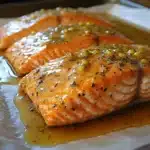
Baked Salmon with Brown Sugar Glaze
Ingredients
- Salmon Fillets: Fresh or frozen (thawed), skin on or off, about 1.5-2 pounds. Salmon is the star, providing rich flavor and healthy fats.
- Brown Sugar: Light or dark brown sugar, ½ cup packed. Brown sugar creates the signature sweet and caramelized glaze, adding depth of flavor.
- Soy Sauce: Low sodium soy sauce, ¼ cup. Soy sauce brings a savory umami element to balance the sweetness and tenderize the salmon.
- Olive Oil: Extra virgin olive oil, 2 tablespoons. Olive oil adds moisture and helps the glaze adhere to the salmon, also contributing healthy fats.
- Lemon Juice: Freshly squeezed lemon juice, 2 tablespoons. Lemon juice brightens the flavors, cuts through the richness, and complements the salmon beautifully.
- Garlic Powder: 1 teaspoon. Garlic powder adds a subtle savory depth to the glaze, enhancing the overall flavor profile.
- Paprika: Smoked paprika or regular paprika, ½ teaspoon. Paprika adds a touch of smokiness and color to the glaze, deepening the flavor.
- Black Pepper: Freshly ground black pepper, ¼ teaspoon. Black pepper provides a subtle spice and enhances all the other flavors.
- Optional Garnishes: Fresh parsley, lemon wedges, sesame seeds. These garnishes add visual appeal and a fresh finish.
Instructions
- Preheat the Oven and Prepare Baking Sheet: Preheat your oven to 400°F (200°C). Line a baking sheet with parchment paper or foil for easy cleanup. Parchment paper prevents sticking, while foil can be helpful for containing any glaze drips.
- Prepare the Salmon: If using frozen salmon, ensure it is fully thawed. Pat the salmon fillets dry with paper towels. This helps the glaze adhere better and ensures a nice sear if you choose to broil at the end. Place the salmon fillets skin-side down (if skin-on) on the prepared baking sheet, leaving some space between each fillet for even cooking.
- Make the Brown Sugar Glaze: In a small bowl, whisk together the brown sugar, soy sauce, olive oil, lemon juice, garlic powder, paprika, and black pepper until well combined. Ensure the brown sugar is mostly dissolved into the liquid ingredients, creating a smooth glaze.
- Glaze the Salmon: Generously brush the brown sugar glaze evenly over the top and sides of each salmon fillet. Make sure each piece is nicely coated to maximize flavor and caramelization. You might have a little glaze leftover, which is perfect for basting later.
- Bake the Salmon: Place the baking sheet in the preheated oven and bake for 12-15 minutes, or until the salmon is cooked through and flakes easily with a fork. The cooking time will vary depending on the thickness of your salmon fillets. Start checking for doneness around 12 minutes. The internal temperature should reach 145°F (63°C).
- Optional Broil for Caramelization (Optional): For an extra caramelized and slightly crispy top, you can broil the salmon for the last 1-2 minutes of cooking. Keep a very close eye on it to prevent burning, as the brown sugar glaze can caramelize quickly under the broiler. Position the baking sheet about 6 inches from the broiler and broil for a short time until the glaze is bubbly and slightly darkened.
- Rest and Garnish: Once cooked, remove the salmon from the oven and let it rest for a few minutes before serving. This allows the juices to redistribute, resulting in more tender and flavorful salmon. Garnish with fresh parsley, lemon wedges, and sesame seeds (if using) for added freshness and visual appeal.
- Serve Immediately: Serve the baked salmon immediately while it’s warm and the glaze is still glistening. It pairs wonderfully with a variety of sides (see “How to Serve” section below).
Nutrition
- Serving Size: one normal portion
- Calories: 450
- Fat: 25g
- Protein: 40g

